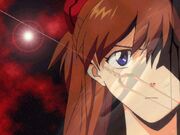
A waitress from the Bishojo game Pia Carrot 3.
- In this article, "manga" refers to Japanese art in general. For the comics, see Japanese comics.
Manga is, literally, the Japanese word for "comic"; outside of Japan, or in Japan, it usually refers to Japanese comics or a style of art which originated in Japanese comics. This style of art is characterised by a wide variety of techniques, especially large, life-filled eyes and interesting hair-colours and styles. This article shall hereforth use the term "manga" as referring to the manga art-style.
Manga as an art-style is designed to bring out the emotions and feelings of the characters who are drawn in that style. For example, the direction of the character's eyebrows, the size or style of their eyes or mouth, and other changes in the character's face and body posture can easily tell whether they are happy, sad, angry, annoyed, hateful, or a number of other emotions.

Inuyasha's enraged face.
The style of manga varies greatly from artist to artist and there is therefore no complete description of its style. Some characteristics which are often found in manga art include:
- Expressions are often extremely exaggerated. For example, expressions known as "facefaults" sometimes occur in anime when characters are suprised or shocked.
- Embarassed characters will often temporarily produce a huge "sweat-drop".
- Angry or "intense" characters may have a vein or stressmark on their forehead. Stressmarks consist of four, stylized, bulging "veins".
- Angry women may randomly pull a mallet or some other object out of nowhere in order to bash an annoyance over the head. See hammerspace.

Asuka of Neon Genesis Evangelion.
The style of Anime -- Japanese animation -- is heavily influenced by manga and has perhaps popularised the style in areas outside of Japan which do not stock manga comics.
To learn how to draw manga, see How to draw manga.
Origins of manga
The first example of manga-style art was probably Osamu Tezuka's manga-comic Astro Boy, which was started in 1952. Astro Boy was later made into the first anime.
Visit www.freewebs.com/bokkaku up an coming mangaka
Manga fanbase
Manga has a huge following on the Internet, with thousands of fansites, message boards, IRC channels, chatrooms, telnet servers, and other communications. Manga and anime fans have created "smileys" for them to use when communicating; for example, ^_^; represents a sweatdrop.
The term "manga"
Manga can refer to a variety of related things: in Japan, it is sometimes used to refer to the art style, Japanese comics, and anime; some of Europe uses it the same as Japan, while other parts use it just for Japanese comics; elsewhere, most of the English speaking world uses manga to refer to the comics.
In most languages, manga stays as manga and is not translated (see Translations of the term "Manga"). Manga could be written as 漫画 in Japanese.
The plural of manga is also manga; "mangas" is rarely used. This is due to Japanese grammar rules.